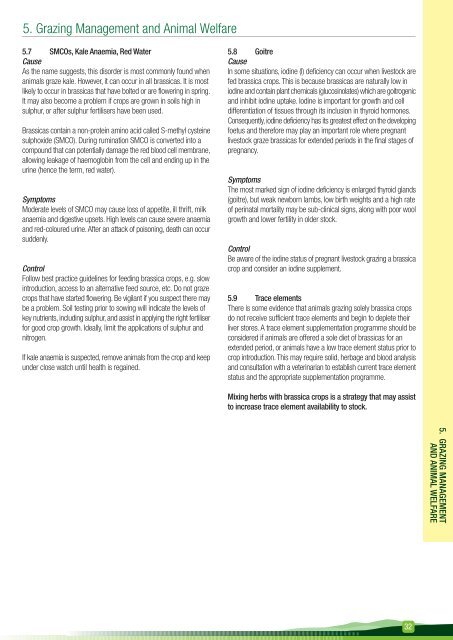Brassica Reference Manual - Agricom
Brassica Reference Manual - Agricom
Brassica Reference Manual - Agricom
You also want an ePaper? Increase the reach of your titles
YUMPU automatically turns print PDFs into web optimized ePapers that Google loves.
5. Grazing Management and Animal Welfare<br />
5.7 SMCOs, Kale Anaemia, Red Water<br />
Cause<br />
As the name suggests, this disorder is most commonly found when<br />
animals graze kale. However, it can occur in all brassicas. It is most<br />
likely to occur in brassicas that have bolted or are flowering in spring.<br />
It may also become a problem if crops are grown in soils high in<br />
sulphur, or after sulphur fertilisers have been used.<br />
<strong>Brassica</strong>s contain a non-protein amino acid called S-methyl cysteine<br />
sulphoxide (SMCO). During rumination SMCO is converted into a<br />
compound that can potentially damage the red blood cell membrane,<br />
allowing leakage of haemoglobin from the cell and ending up in the<br />
urine (hence the term, red water).<br />
Symptoms<br />
Moderate levels of SMCO may cause loss of appetite, ill thrift, milk<br />
anaemia and digestive upsets. High levels can cause severe anaemia<br />
and red-coloured urine. After an attack of poisoning, death can occur<br />
suddenly.<br />
Control<br />
Follow best practice guidelines for feeding brassica crops, e.g. slow<br />
introduction, access to an alternative feed source, etc. Do not graze<br />
crops that have started flowering. Be vigilant if you suspect there may<br />
be a problem. Soil testing prior to sowing will indicate the levels of<br />
key nutrients, including sulphur, and assist in applying the right fertiliser<br />
for good crop growth. Ideally, limit the applications of sulphur and<br />
nitrogen.<br />
If kale anaemia is suspected, remove animals from the crop and keep<br />
under close watch until health is regained.<br />
5.8 Goitre<br />
Cause<br />
In some situations, iodine (I) deficiency can occur when livestock are<br />
fed brassica crops. This is because brassicas are naturally low in<br />
iodine and contain plant chemicals (glucosinolates) which are goitrogenic<br />
and inhibit iodine uptake. Iodine is important for growth and cell<br />
differentiation of tissues through its inclusion in thyroid hormones.<br />
Consequently, iodine deficiency has its greatest effect on the developing<br />
foetus and therefore may play an important role where pregnant<br />
livestock graze brassicas for extended periods in the final stages of<br />
pregnancy.<br />
Symptoms<br />
The most marked sign of iodine deficiency is enlarged thyroid glands<br />
(goitre), but weak newborn lambs, low birth weights and a high rate<br />
of perinatal mortality may be sub-clinical signs, along with poor wool<br />
growth and lower fertility in older stock.<br />
Control<br />
Be aware of the iodine status of pregnant livestock grazing a brassica<br />
crop and consider an iodine supplement.<br />
5.9 Trace elements<br />
There is some evidence that animals grazing solely brassica crops<br />
do not receive sufficient trace elements and begin to deplete their<br />
liver stores. A trace element supplementation programme should be<br />
considered if animals are offered a sole diet of brassicas for an<br />
extended period, or animals have a low trace element status prior to<br />
crop introduction. This may require solid, herbage and blood analysis<br />
and consultation with a veterinarian to establish current trace element<br />
status and the appropriate supplementation programme.<br />
Mixing herbs with brassica crops is a strategy that may assist<br />
to increase trace element availability to stock.<br />
32<br />
5. GRAZING MANAGEMENT<br />
AND ANIMAL WELFARE


